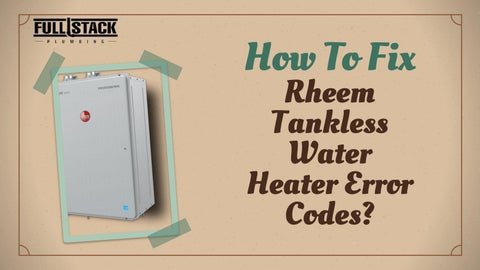
Here’s the deal: water heaters, much like any other appliance, can sometimes hit a snag. The Rheem water heater displays error codes as a way to communicate issues, much like how your car uses warning lights on the dashboard. Think of ‘Error Code E1’ as your water heater’s way of waving a little flag to say, “Hey, something’s up!” It usually indicates a failure in the combustion or ignition process. But don’t worry, you don’t need to be a plumbing expert to troubleshoot this. Let’s break this down together.
Understanding Error Code E1: What Does It Mean?
Before diving into solutions, it’s crucial to understand what’s causing the Error Code E1. Essentially, it’s related to the water heater’s failure to ignite properly. Imagine if you tried to light a candle, but the wick was damp. No matter how many matches you strike, it just won’t light. Similarly, your water heater is trying to initiate combustion but something’s getting in the way.
You might be wondering, “What’s causing this complication?” Typically, this error can arise from a few factors. It could be something as simple as a blocked gas supply or vent, or a more complex issue like a faulty flame sensor. Picture the flame sensor as the water heater’s sense of smell — if it can’t detect the right signals, things won’t ignite properly. Often, environmental factors, such as dust or air pressure changes, might also play a contributing role.
So, why does this matter? Understanding these basics helps you figure out whether a reset will magically fix the issue or if further investigation is needed. Being informed empowers you to diagnose and address the situation effectively, saving you from potential water heater woes down the line.
Step-by-Step: How to Reset Your Rheem Water Heater
If you suspect a reset might do the trick, you’re probably wondering how to go about it. Fortunately, resetting your Rheem water heater is a straightforward process that you can handle without any special tools. Imagine it like rebooting your computer when it’s acting up — sometimes, all it takes is a fresh start.
First, locate the reset button on your water heater. Typically, you’ll find it on the front of the unit, often in the form of a small red button. Press and hold this button for a few seconds to initiate the reset process. You’ll know you’ve done it right when the panel lights blink or the error code disappears.
After resetting, give the heater a little time to stabilize. It’s kind of like letting your car’s engine warm up on a cold morning. During this brief waiting period, monitor the heater to ensure the error code doesn’t reappear. If it does, that’s a sign there might be another underlying issue at hand, and you’ll need to explore further troubleshooting steps.
When a Reset Isn’t Enough: Further Troubleshooting
Sometimes, a reset might not be the magical fix you were hoping for. If the Error Code E1 rears its head again, don’t fret. This is your water heater’s way of signaling that it needs a bit more TLC. So, what should you do next?
First, check the gas supply. Ensure the gas valve is open and that there’s adequate gas flow. Think of it like ensuring your car has enough fuel to run smoothly. Next, inspect the venting system. Any obstructions should be cleared away, as blockages can inhibit the ignition process, much like how a blocked chimney can prevent smoke from escaping.
Additionally, it might be worth taking a peek at the flame sensor and ignitor. Over time, these components can get dirty or worn out. Imagine trying to start a fire with damp matches — not very effective, right? Cleaning or replacing these parts may resolve the issue.
Preventative Measures: Keeping Error Code E1 at Bay
While it’s great to know how to tackle the Error Code E1 when it occurs, preventing it from happening in the first place is even better. Regular maintenance is key. Much like getting your car serviced regularly keeps it running smoothly, routine check-ups for your water heater can prevent many common issues.
Schedule an annual inspection with a qualified technician to keep your water heater in tip-top shape. They’ll be able to clean and adjust components, ensuring everything is running as it should. Also, keeping the area around your water heater clean and clear can help reduce the chance of dust and debris causing problems.
In conclusion, while resetting your Rheem water heater might fix Error Code E1 in some cases, it’s important to understand when further action is necessary. By following these guidelines, you’ll be better equipped to keep the hot water flowing smoothly in your home — no cold showers required!